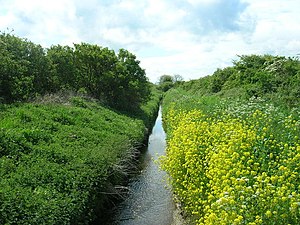River Hertford
The River Hertford is a river in Yorkshire, whose original, natural course marks part of the northern boundary of the East Riding of Yorkshire, with the county's North Riding. The Hertford is a tributary of the River Derwent, which latter river in its turn marks the boundary of the two ridings.
- Location map: 54°11’49"N, 0°29’54"W
The River Hertford rises close to Muston near the seaside town of Filey. Despite being only a mile and a half from the North Sea to its eastern side, the river flows westwards for ten miles to the River Derwent at Haybridge Farm, north of Ganton. The Hertford has been referred to as a 'backward-flowing river' because it flows away from the sea.[1]
Ekwall suggests the name derives from a ford over the river, which became the name by back formation.[2]
Star Carr, a Mesolithic archaeological site, lies close to the river. Star Carr was on the edge of a nine-thousand year old Stone Age wetland known as, 'Lake Flixton' (near Flixton). This area is now known as the River Hertford Floodplain and extends from Muston in the east to Ganton in the west.[3]
Originally the river meandered, but the Muston & Yedingham Drainage Act 1800 resulted in the River Derwent and the River Hertford being straightened by cutting a new course for each.[4] The Hertford was hand dug during the industrial revolution (local stories hold that the men who dug the new channel were prisoners from the Napoleonic Wars).[5]
The River Hertford catchment suffers from the discharges of three sewage plants at Folkton, Hunmanby and Seamer. This not only affects the quality of the river but also that of the Derwent downstream of Haybridge.[6]
Outside links
| ("Wikimedia Commons" has material about River Hertford) |
References
- ↑ "River Hertford". http://www.ruralprogrammeseastyorkshire.co.uk/past-programmes/leader-2007-2013/funded-projects/waterways-partnership/our-waterways/?entryid108=203033. Retrieved 25 October 2016.
- ↑ Ekwall, Eilert, The Concise Oxford Dictionary of English Place-Names. Oxford, Oxford University Press, 4th edition, 1960. p. 195 ISBN 0198691033
- ↑ "Farmers protect Stone Age land". BBC York & North Yorkshire. 5 November 2009. http://news.bbc.co.uk/local/york/hi/people_and_places/nature/newsid_8344000/8344426.stm. Retrieved 25 October 2016.
- ↑ "Brief history of the parish". http://www.willerbystaxtonpc.com/about-parish/brief-history-of-willerby-parish/. Retrieved 25 October 2016.
- ↑ Bayes, Kevin; Linfoot, Harriet; Green, Steven; Bowles, Judith. "Yorkshire's Hidden Vale" (PDF). 6.1.2: Yorkshire Wildlife Trust. p. 12. http://www.ruralprogrammeseastyorkshire.co.uk/EasySiteWeb/GatewayLink.aspx?alId=203153. Retrieved 25 October 2016.
- ↑ "Derwent Consultation Report" (PDF). Environment Agency. February 1997. p. 18. http://www.environmentdata.org/fedora/repository/ealit:516/OBJ/19001123.pdf. Retrieved 27 October 2016.
